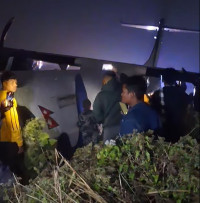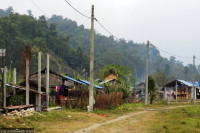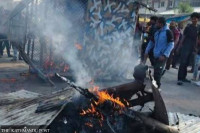National
Despite assurances from expeditions and government, a ‘traffic jam’ on Everest kills climbers again
Though a fixed climbing timetable was supposed to reduce overcrowding on Everest, climbers were forced to wait for hours on the ascent and descent.
Sangam Prasain
Just days after expedition leaders and the government had claimed that overcrowding on Everest was not a worry, two climbers died on Wednesday due to an hours-long ‘traffic jam’. A third climber died due to exhaustion on Thursday.
Mountaineering agencies and the government liaison officer at Base Camp had both told the Post on Tuesday that since a fixed climbing timetable had been instituted, overcrowding on the final push to the summit would be unlikely.
However, Anjali S Kulkarni and Kalpana Das, both Indian citizens, and American Donald Lynn Cash both died while descending from the summit. Their deaths were attributed primarily to a long queue of both ascending and descending climbers, forcing many to wait for hours at altitudes above 8,000 metres.
Wednesday saw the longest single-day weather window of 24 hours to summit Everest, leading to 250 climbers vying for the summit. More than 200 made it to the top.
Kulkarni, 54, from Mumbai, died above 8,000 metres, in what is known as the Death Zone, as she was descending after reaching the summit.
Thupden Sherpa, general manager of Arun Treks and Expeditions, Kulkarni’s expedition agency, said that she died of “exhaustion”.
“Anjali and her husband were forced to wait for hours to reach the summit as there was a long queue on the slopes of Everest,” said Thupden. The couple had managed to reach the summit, but lost a lot of energy in the process, leading to Kulkarni’s death.
“The Sherpa guides supported her while coming down, but she could not make it,” Thupden said. “The guides are now helping her husband, who is also weak, descend. As of Thursday afternoon, Kulkarni’s husband has been reported at Camp II.”
Das, who reached the summit on Thursday at 12:55pm, died while descending the mountain.
Cash, too, died while descending from the summit, 15 metres below the Hillary Step, which stands at 8,790 metres.
The 55-year-old American died of altitude sickness as he had lost energy spending hours on the ridges of Everest, waiting to reach the top, said Pasang Tenje Sherpa, chairman of Pioneer Adventure, Cash’s expedition agency.
“He collapsed as soon as he reached the summit,” Pasang told the Post.
The American had hired two specialised guides due to his body weight, but ultimately, they were unable to help him descend safely.
“The guides brought him down but he was unable to move,” said Pasang.
Pasang admitted that it was “obviously” the traffic jam that led to Cash’s death but asked that the Post not report it that way so as not to “injure the country’s prestige”.
Nepali officials said they were planning to run a timetable for climbers but were unable to implement it. Officials and expedition leaders had told the Post on Tuesday that the record influx of climbers was manageable as long as the weather favoured them on Wednesday.
“All other mountains can be climbed around the year,” said Meera Acharya, director at the department of tourism. “However, there is only a two-week window to climb Everest, leading to a traffic jam like this year.”
A ‘traffic jam’ occurs on Everest when many climbers vie for the summit at the same time, and can be especially dangerous above 8,000 metres, the ‘Death Zone’. The last steep challenge before the summit occurs after the Hillary Step, a vertical rock face at 8,790m, which many climbers said was dislodged in the 2015 earthquake. In a ‘traffic jam’ exhausted climbers are often forced to wait for several hours, awaiting their turn to ascend or descend on a single rope, increasing chances of exhaustion, frostbite or altitude sickness. Climbers could also run out of oxygen during the final phase of the ascent.
In 2012, around 260 climbers had made a final push for the summit, but only 179 had successfully made it to the top. That year too, four climbers died of exhaustion and altitude sickness while descending from the summit because they had to spend long hours due to overcrowding on the mountain.

More than 200 mountaineers ascended Mount Everest on Wednesday, setting a new record for the highest number of climbers to stand on top of the world in a single day.
Two-hundred and fifty climbers had started from Camp IV, at 7,900 metres, on Tuesday night, hoping to reach the top of Everest by Wednesday morning, with just a week remaining before the Spring ascent window closes.
Conditions were exceedingly favourable on Tuesday night and Wednesday, leading to a 24-hour window—the longest ever single-day weather window in history.
Pasang said that they had informed the Cash family, including his insurance company and the US Embassy in Kathmandu, about his death.
“We are waiting for his family’s call on whether to bring the body back,” he said. There is great risk involved in bringing a body down from 8,700 metres, and it would also cost a minimum of $70,000.
Wednesday’s casualties mark the fifth death on Everest this season, which started on May 15. On May 16, Irish mountaineer Seamus Lawless went missing from the Everest balcony area. His expedition agency had launched a search mission but was unable to locate him. Last week, Indian climber Ravi Thakar died at Camp IV while returning from the summit.
On April 18, 2014, there was an avalanche near Everest Base Camp which killed 16 Nepali guides. Rescuers pulled out 13 bodies and the remaining three were never recovered as search and rescue operations were called off due to too much risk. Then in 2015, quake-triggered avalanches killed 20 climbers.
In 2016 and 2017, Everest claimed lives of six and five climbers respectively. Last year, there were five deaths on Everest.
“The traffic jam issue continues to become a serious problem every year,” Acharya, the tourism department official said. “We have to collectively discuss a solution for this.”




 8.12°C Kathmandu
8.12°C Kathmandu










%20(1).jpg&w=300&height=200)



